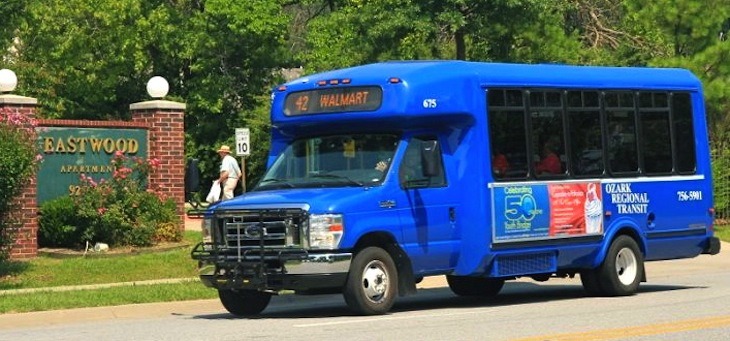ORT board looks to take deeper dive into bus rapid transit study
by November 30, 2017 8:01 pm 448 views

Board members for Ozark Regional Transit discussed a plan to establish a light-bus rapid transit system along U.S. Highway 71B, from Fayetteville to Bentonville, after reviewing a report completed by consultant KFH Group on the feasibility of the transit system in Northwest Arkansas. But the board wanted to go more in-depth on the report and planned to meet again over the next two months to discuss it in more detail.
On Thursday (Nov. 30), Joel Gardner, executive director for the Springdale-based transit provider, talked about the report and looked for direction from the board on it before he presents it to the more than 30 stakeholders.
In the report, the consultant recommended a two-year pilot project to establish the transit system, which is expected to have 5,000 one-way trips daily after operating for two to three years. The report included multiple options for bus rapid transit based on the frequency of the buses at each bus stop, and Gardner liked the option that would cost $15.876 million for startup and operating costs for the first year. After the first year, annual operating costs would be about $3.57 million.
In this option, the frequency of buses at each stop would be 10 minutes during peak hours, between 6 a.m. and 9 a.m. and 4 p.m. and 7 p.m., and off-peak, the frequency of buses at each stop would be 30 minutes. The level of frequency would require 21 buses to maintain. The report identified 22 sites for bus stations on Highway 71B, between Martin Luther King Boulevard in Fayetteville and the Wal-Mart Logistics Facility in Bentonville.
Gardner suggested that each major city along the route have a primary bus station, and other stops might be a shelter initially.
“We don’t beef everything up at the beginning,” he said.
The proposed level of service would use the existing highway but could accelerate buses that are running behind with signal prioritization. This allows the buses to send a signal to traffic lights in order for them to remain green longer or to shift to green. Other technology included in the system would be an automatic vehicle locator, allowing dispatchers to know the locations of the buses and their speed; and real time information at stations and on a smartphone app, showing riders when the next bus will arrive.
Gardner said the biggest challenge would be the signal prioritization. The buses on the transit system would not take priority over ambulances and other emergency vehicles, which use signal prioritization. Rogers doesn’t use signal prioritization but Bentonville, Fayetteville and Springdale have it.
A concern Gardner had after the two-year pilot is completed and the service doesn’t continue is what happens to the infrastructure and buses that were used in the pilot. Other concerns included what other information to ask for from the consultant, what information to present to the stakeholder group and how to find a revenue stream for the service. “It all comes back to money,” Gardner said.
Board member Don Marr, who represents Fayetteville, said an investment this large would require a public vote.
Also in the consultant’s report were the results of two surveys, one to the general public and another to employees of major Northwest Arkansas employers including J.B. Hunt Transport Services, Simmons Foods, Tyson Foods and Wal-Mart Stores.
Board member Jim Kimbrough, who represents Washington County, said the people who responded to the survey aren’t the ones who will use it, and emphasized the importance of those who commute between Fayetteville and Bentonville, along Interstate 49.
“That’s where the traffic is,” he said.
But Marr said those who have moved here from larger cities to work at the large corporations in the area will be more likely to use it.
